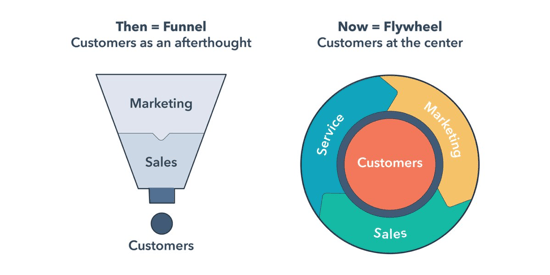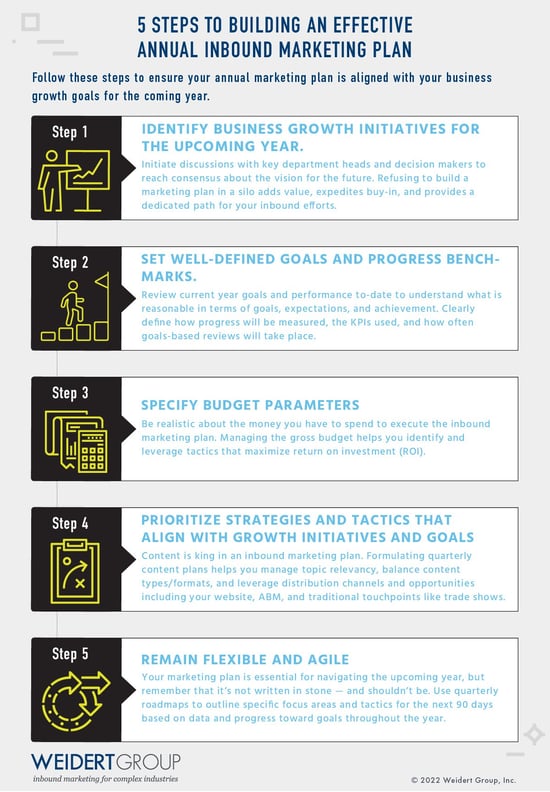How to Create a Marketing Plan for 2023: Follow These 5 Steps
Written by
Creating an annual marketing plan that aligns with your company’s growth objectives is no picnic. However, next-level inbound marketing programs — the ones that align marketing, sales, and service teams — use the power of the flywheel.
An inbound marketing plan centered around the flywheel leverages force, friction, and the momentum the combination creates, and it’s designed to help complex organizations meet their growth goals.

As you begin your marketing planning process for 2023, refer to our infographic for an at-a-glance look at the process that sums up how to build a plan. Below that, we’ll dig into each step, so read on!
RELATED: Free Annual Inbound Marketing Plan Template
1. Identify business growth initiatives for the upcoming year
A marketing plan developed around unclear — or worse, unknown — business growth initiatives is an exercise in futility. Reach out to key department heads and decision makers to gather their input on the collective vision of the future. Lean into conversations and roundtables that get everyone on the same page before you start formulating a plan.
Avoiding the mistake of building a marketing plan in a silo adds value, expedites buy-in, and provides a dedicated path for your inbound efforts.
2. Set well-defined goals and progress benchmarks
Assembling a team to provide insights and perspectives about growth initiatives is one thing. Coming to consensus on goals and what successful completion of those goals looks like is another.
The key here is twofold. First, be realistic. Review current year goals and performance to-date to understand what is reasonable in terms of expectations and achievement.
Second, define how progress will be measured. Be specific about key performance indicators (KPIs) for lead attraction and conversion, MQL and SQL percentages, and a regular progress/goals review cadence — generally 90-day intervals.
3. Specify budget parameters
Just like with goals and benchmarks, you have to be realistic about the money you have to spend to execute an annual inbound marketing plan. Knowing the gross budget simply helps in “big picture” management.
Which tactics are worth putting money behind to maximize return on investment (ROI)? Is there a better way to adjust frequency, content format, technologies, etc. to stay within the planned spend and still generate sufficient results?
RELATED: The Absolute Best Marketing Budget Templates — A Must-Read For B2B Marketing Managers
4. Prioritize strategies and tactics that align with growth initiatives and goals
With everything in place — the path, goals, progress benchmarks, budget — you can finally settle into the annual marketing planning process, most importantly: the tactics. Since inbound is fueled by content, it’s essential to identify both the type of content you’ll want to develop and the channels you’ll use for distribution.
Creating quarterly content plans that specify the topics and formats is an effective way to develop a regular cadence and to ensure you’re using each distribution channel (blogs, videos, advanced content, etc.) to your best advantage — including your website.
Commit to not letting it lag by implementing growth driven design (GDD) to keep your site fresh, relevant, and updated with continuous learning and improvements. Don’t ignore proven target-based strategies either. Account based marketing (ABM) focuses your efforts on prospective best fits. Plus, boost results with direct mail, email blasts, and trade shows.
5. Remain flexible and agile
Your annual marketing plan is essential for navigating the upcoming year. But remember, it’s not written in stone; unforeseen circumstances will arise. You’ll want to be nimble enough to use data about what’s working and what’s not throughout the year to adjust.
Consider using an annual marketing plan in tandem with quarterly marketing roadmaps that contain specific focus areas and tactics for the next 90 days. This doesn’t mean derailing your marketing plan, simply adjusting it to address the variables while keeping your larger initiatives on track.
Now, when you’re thinking about how to create a B2B marketing plan, look at the above infographic. You’ll be reminded that the marketing planning process isn’t quite so intimidating.
Learn more about the essentials of creating an annual marketing plan in our free guide. Click below to read it now and then download the accompanying template to start creating your own plan.
Subscribe To Our Blog
Information. Insights. Ideas. Get notified every time a new Weidert Group blog article is published – subscribe now!
You May Also Like...

Artificial Intelligence
Revenue-Driving B2B Content Marketing Strategy with Andy Crestodina

Artificial Intelligence
AI Agents Are Here—How Smart Businesses Are Using Them Now

Inbound Marketing
Podcasting Playbook: What We Learned After 100 Days of Running a B2B Podcast
Accelerate Your Growth with
Weidert Group
If you’re ready to explore a partnership, request a personalized consultation with our team.


